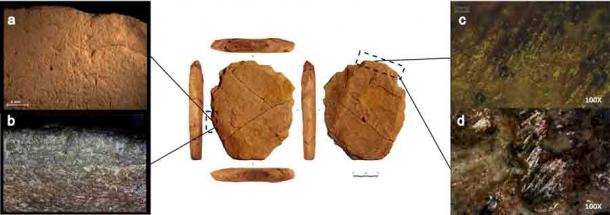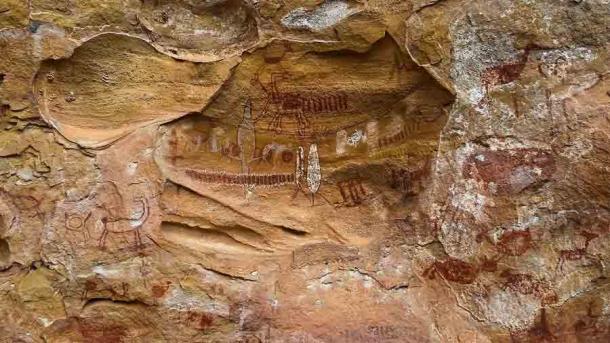Evidence excavated from a fertile archaeological site in Brazil known as Vale da Pedra Furada may force researchers to re-evaluate existing theories about when modern humans first arrived in South America. The evidence in question is a single stone tool , with rare features that make it clear the object was man-made. This unusual tool was removed from a stratigraphic layer at Vale da Pedra Furada that has been reliably dated to at least 24,000 years in the past. It is unlike any other artifact found in this region, or anywhere else in South America for that matter.
“Until now, the official North American archeology considered that the first settlers arrived in America 15,000 years ago,” said Ignacio Clemente-Conte, an archaeologist affiliated with the Mila y Fontanals Institute on Humanities Research in Barcelona. “However, the artifact discovered here was found in one of the archaeological levels that are between 27,600 and 24,000 years old.”
Clemente-Conte is part of a large international team of researchers, known as the Franco-Brazilian Mission, who’ve been exploring dozens of archaeological sites in Serra da Capivara National Park in northeastern Brazil since 2011. The researchers only announced their discovery of the unusual tool in the journal PLOS One in March, but it was actually recovered in 2016, from cliff-side, multilayered archaeological site known as Vale da Pedra Furada.

Fig 13. Traceological analysis of the artifact #255660. The octagonal shape of the Vale da Pedra Furada prehistoric stone tool strongly suggests is was manmade and the soil it was found in dated back to between 27,600 and 24,000 years ago, which challenges the current theories of when people first arrived in South or North America. ( PLOS One )
The Vale da Pedra Furada Tool Could Change Everything
The Vale da Pedra Furada tool is flat, disc-shaped, and large, measuring 8 inches by 7 inches by 1 inch thick (21 cm x 18.5 cm x 2.9 cm). It was made from a type of rock known as silty sandstone, which is unusual since most ancient tools found in the region were made from quartz or quartzite.
It was modified into the shape of a hexagon, and sections around the perimeter had been chipped away to create sharp grooves and pointed ends. Both sides of the stone have been worked on, both on the flat faces and on the sharper edges. Most likely, this tool would have been used to cut, slice, or poke through animal hides or flesh, wood, and plant fibers, as they were being processed for various uses.
Based on their in-depth study of this objects, the researchers believe the Vale da Pedra Furada tool was modified on eight occasions. Five of the modifications changed the shape and characteristics of the flat faces, while the other three modifications changed the geometry of the outer edges.
This suggests the tool was put to multiple uses and may have been passed around to different individuals who had different jobs or responsibilities. The tool was badly cracked in two directions, which meant it must have been heavily used before it finally broke and could no longer function.
In the layer with the sandstone tool, the archaeologists found approximately 2,200 stone objects in total, all of which they say are tools. Most were made from quartz or quartzite, and several had sharp points on the end.
There has been ongoing controversy over whether objects like this are really man-made. While their shape suggests they were, there are many skeptics who remain unconvinced. They know that natural processes can sometimes cause rocks to break into shapes that resemble man-made objects. They therefore demand that a high standard of proof be met before stone objects found in unexpectedly ancient layers are definitively identified as human-crafted tools.

Just some of the exceptional rock art found at Vale da Pedra Furada site in Brazil, where the unusual stone tool was discovered. (Diego Rego Monteiro / CC BY-SA 4.0 )
Vale da Pedra Furada Tool: Creates Scientific Controversy
The Franco-Brazilian Mission has been working at Vale da Pedra Furada since 2011. Over the years, they have found many examples of what they believe are ancient stone tools dating back to before 14,000 BC. But the skeptics have remained steadfast in their refusal to accept such a conclusion.
Archaeological digs in Peru, Venezuela, Chile, and Argentina have produced abundant artifacts that show humans were present in those locations between 11,000 BC and 14,000 BC. The greater archaeological and anthropological communities have accepted this evidence as legitimate. But they’ve remained rigid in their rejection of anything that pushes the timeline back further.
“Acceptance of sites dating to earlier than 14,000 BC … seems to be much more difficult,” the Franco-Brazilian Mission archaeologists wrote, in a 2014 article published in the journal Antiquity. “All discoveries made have been systematically and legitimately discussed, which is justified, but also systematically and surprisingly rejected, without exception. This has occurred, in particular, for sites in north-eastern Brazil, in the Serra da Capivara region.”
In some instances, skeptics have said that so-called tools were actually natural artifacts. In other cases, they’ve questioned the results of the dating methodologies , claiming they were inaccurate and that the sites where tools have been found are really much younger.
Some of the evidence the skeptics rely on comes from genetic analysis. Researchers with expertise in ancient DNA and evolution say that Native North Americans and Native South Americans didn’t exist as distinct peoples until about 23,000 years ago. Genetic study suggests they branched off from their Asian ancestors at about that time, when all were living in the region that is now Canada. They’d gotten that far by crossing a land bridge that connected Asia to what is now Alaska, during the last Ice Age when sea levels were much lower. Several thousand years later, the theory asserts, these people migrated to North and South America, arriving at their southernmost destinations around 14,000 BC.
Until now, this theory has held firm against all possible contradictory evidence. And that explains why the Franco-Brazilian archaeologists are so excited by their discovery of the unique, disc-shaped tool, which was found in an underground layer of Vale da Pedra Furada soil that has been dated to 24,000 to 27,600 years in the past. This precedes the alleged time of arrival of the first Native South Americans, and even comes from before the time when the first Native North and South Americans supposedly diverged from their Asian ancestors.

A land bridge of a different kind at the Vale da Pedra Furada site, which is part of the Serra da Capivara National Park in Brazil, where the stone tool was discovered. How and when did the first people migrate to the Americas is now questionable because of this remarkable stone artifact. (Cleude / Public domain )
If Humans Came to South America Earlier, Who Were They?
It is notable that the members of the Franco-Brazilian Mission waited nearly five years before announcing their discovery of the anomalous stone tool found at the Vale da Pedra Furada site. They clearly wanted to do as much research on this item as possible, to make sure they could present a strong case for its antiquity and man-made origins. If their conclusions stand up to scrutiny, many archaeologists and prehistoric scholars will have to revise their theories about when modern man first settled in South America .
One interesting aspect of this discovery is how it departs from the genetic evidence. If there were people living in what is now Brazil before Native North and South Americans even existed, it means someone else must have arrived in South America before they did.
At least for now, that question of who these people were and where they came from will have to remain a mystery. The soil where the anomalous stone tool was found is far too acidic to preserve bones, meaning no human fossils from 24,000 years in the past will ever be found at Vale da Pedra Furada.
Top image: Fig 10. Macro-trace analysis of the artifact #255660. The Vale da Pedra Furada stone tool may rewrite the timeline of when the first people arrived in South America. Source: PLOS One
By Nathan Falde
Related posts:
Views: 0
 RSS Feed
RSS Feed

















 May 20th, 2021
May 20th, 2021  Awake Goy
Awake Goy  Posted in
Posted in  Tags:
Tags: 
















